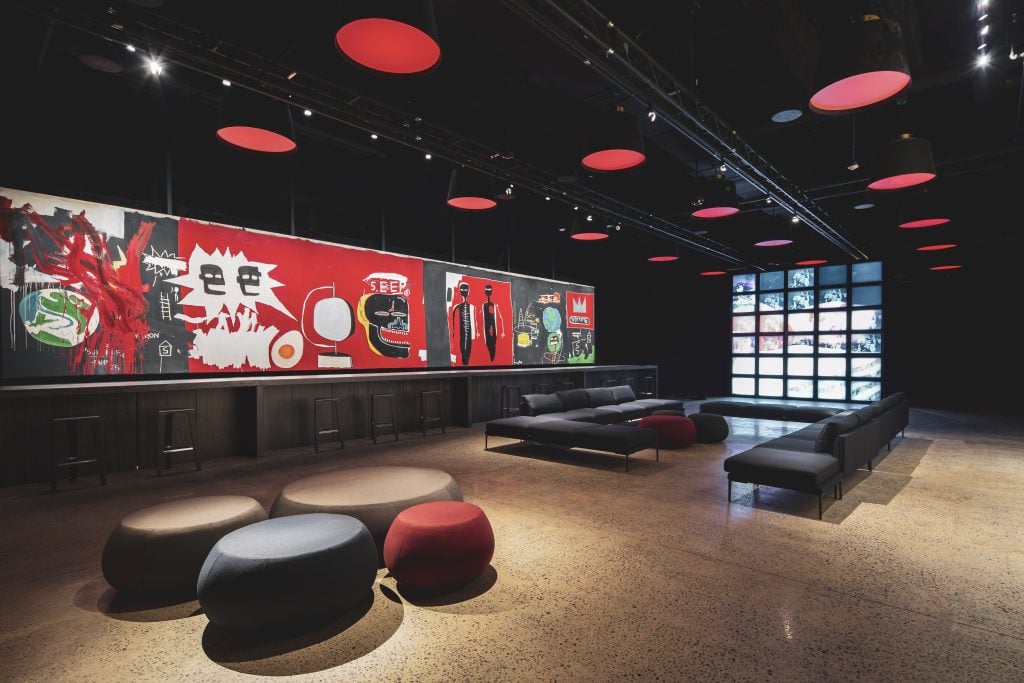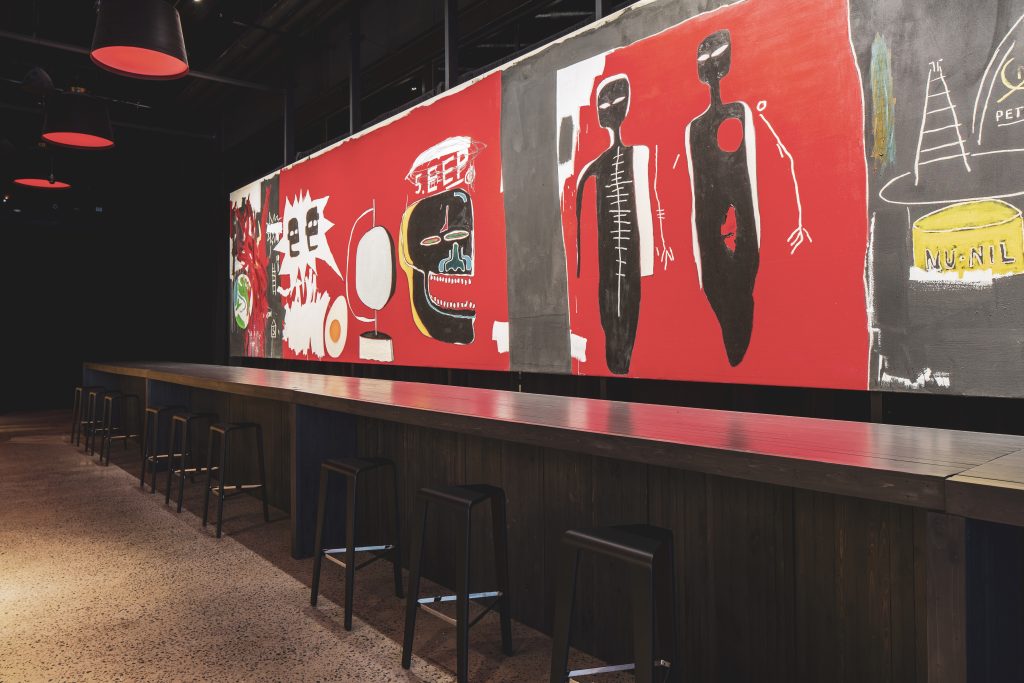The Art Detective
Basquiat, Inc.: How the Artist’s Estate Built a Licensing Empire of Branded Barbies, Dog Hoodies, Coach Backpacks, and More
Is it profiteering, or protecting a legacy?

Is it profiteering, or protecting a legacy?

Dog hoodies. iPhone cases. Coach backpacks. Candles. Mugs. Skateboards. Pins. Socks.
These are just some items offered in the retail store outside the exhibition “Jean-Michel Basquiat: King Pleasure” in New York. The artist’s iconic imagery appears on T-shirts and water bottles. Prices range from $3 for a postcard to $1,300 for a Coach purse. An alpaca blanket will set you back $375. Most of the items are under $75.
Three decades after his death at 27 of a drug overdose, Basquiat has become a global brand like few others—and his estate is busy capitalizing on the artist’s dizzying popularity. Tickets to “King Pleasure,” with its 190 original works of art and ephemera, start at $35 for adults and go to $65 for those eager to skip the line. That’s more than a $25 ticket to the Museum of Modern Art, with its 200,000 artworks, but less than a $99 VIP ticket for last year’s “Immersive Van Gogh” exhibition on Pier 36 in New York, which didn’t contain a single original painting.
The pricey tickets, the retail shop—the commodification of the artist’s legacy irks some, especially those who knew Basquiat during his short, prolific life. (No, these people would tell you, the artist did not use the “Tiffany Blue” pigment in his paintings, as a luxury ad campaign claimed last year). But for the estate, which is now run by Basquiat’s two younger sisters, Lisane Basquiat and Jeanine Heriveaux, with the help of their stepmother, Nora Fitzpatrick, the licensing is a lifeline.

Lisane Basquiat and Jeanine Heriveaux. Photo: Katya Kazakina.
“It’s very important for our family to maintain his legacy,” said Heriveaux in a telephone interview this week. “It would be very easy for us to sell off all of his paintings in order to, you know, take care of our expenses. It is more important for us to hold on to those paintings and not dilute the work by selling off the work and it getting right into the hands of others. And so if the exchange for that is to sell licensed goods, we are O.K. with that.”
The sisters closely guard the number and value of the family’s holdings. The estate has sold some art since the sisters took over in 2013, following the death of their father, Gerard Basquiat. One work, Flexible (1984), fetched $45.3 million at Phillips in 2018, and the auction house has sold other smaller pieces in London and New York.
The value of the artworks on view at the Starrett-Lehigh Building in Chelsea is more than $600 million—possibly way more, some dealers say, thanks to the exhibition’s biggest showstopper, a 41-foot-wide painting, Nu Nile (1985), that used to hang in the Mike Todd room of Palladium, a legendary 1980s New York club (more on that later). Needless to say, very few people can afford an original Basquiat these days.
This is where the licensing comes in.
“Our strategy is to make Jean-Michel’s art accessible through licensing,” said Lisane Basquiat. “If a person can’t afford to purchase a painting, they can still purchase something, some physical thing that gives them the ability to have access to Jean-Michel’s artwork.”
Such thinking is not unique to the Basquiat estate. Licensing in the art world is on the rise, from cultural behemoths like the Metropolitan Museum of Art, (which has forged deals with Harney & Sons teas, Caspari paper goods, and Ann Gish bedding) to living artist Faith Ringgold’s designs for Vans shoes and Ryan McGinness fashion collection for Robert Graham.
The Artists Rights Society, which manages copyright for 122,000 creators worldwide, has a licensing team that attends trade shows in Las Vegas along with conglomerates like Disney and HBO, building bridges between artists, their estates, and big brands. At the Warhol Foundation, a licensing team of four people oversees collaborations with brands like Comme des Garçons, Estée Lauder, and Uniqlo. Licensing generated $3.2 million for the foundation in the fiscal year ending April 30, 2021, down from $10.7 million in 2019.

More Basquiat merch including socks, phone cases, and watch straps. Photo: Katya Kazakina.
During his lifetime, Warhol famously took out a classified ad in 1966 in the Village Voice, seeking to endorse a litany of products with his own name. He appeared in ads for Sony, TDK, and LA Eyeworks, collaborated with the Halston fashion brand and watches with Movado, and produced ad campaigns for Absolut and Perrier. “He broke down traditional barriers between art and commerce,” said Michael Dayton Hermann, head of licensing, sales, and marketing at the Warhol Foundation. “For Warhol, it was all part of a larger creative vision.”
Art and design is a small but fast-growing sector of the licensing universe. In 2019, it represented just 1 percent of the $292.8 billion global licensing market, according to Licensing International, a trade organization. Global art sales were $67.4 billion that year.
The organization’s recent report on the art sector noted that “brand licensing was more important than ever” during the two pandemic years. “This growth was driven not only by the need to find new sources of revenue, however, but also to keep the museums’ brands top-of-mind with consumers at a time when virtual collections ruled the day,” the report said.
For the art sector, licensing is also a way to reach new audiences, and the trend arrives in the midst of a generational shift as younger people aren’t as set on drawing lines between art and commerce, experts said.
To be sure, the Basquiat estate, as well as the Warhol Foundation and ARS, say no to plenty of licensing offers. Instead, these organizations are looking for meaningful alignment.
“Some of the most important licensing decisions we have made at the Foundation aren’t the amazing projects the public sees but, instead, the opportunities we have declined,” Hermann said.
Artists, estates, and institutions are becoming more comfortable with licensing, and at the same time, corporations are recognizing that their affiliation with artists is a great marketing tool.

Dog couture featuring Basquiat’s work. Photo: Katya Kazakina.
“It looks cool, it speaks to a new audience, and it tells a story,” said Andrea Fisher, managing director of merchandise licensing at ARS. Some brands, for example, want to be seen as supporters of women by championing female artists. In 2020, luxury fashion brand Chloé designed tops and tote bags adorned with images by Sister Corita Kent, a nun and Pop artist.
“It’s something we are seeing more and more of,” Fisher added. “While we constantly get requests for Picasso, Matisse, and Warhol, more companies have been asking to collaborate with artists who aren’t household names, but they have an amazing story behind them and can be used as a marketing piece for a brand and for these artists to get to an audience that didn’t know them in the past.”
Back at the “King Pleasure” emporium, VIP guests snapped up $15,000 worth of merch within the first couple of hours of the April 6 opening, including an expensive Coach backpack.
“We picked every single thing in the exhibition and in the retail shop,” said Lisane Basquiat. Her favorite item is a book she wrote with Heriveaux and their stepmother.
“It’s really more of a scrapbook of our family’s life and of Jean-Michel’s life,” she said. “There are personal photos in there, family photographs. It was really a heart project that we did.” The price tag: $55.
One item I didn’t find in the store was a Basquiat Barbie, a Black doll sporting a Basquiat-inspired hairdo and a pantsuit decorated with a jumble of Basquiat imagery.
“I think those sold out as soon as they came out,” said Heriveaux.
 Magnifying Glass
Magnifying GlassA closer look at one work making waves in the market this week

Jean-Michel Basquiat, Nu Nile (1985), in “Jean-Michel Basquiat: King Pleasure.” Photo: Ivane Katamashvili, courtesy of the Jean-Michel Basquiat Estate.
My neighbor, a music executive who used to be on the party circuit in the 1980s, once told me about a massive Basquiat mural that once hung behind the bar in a VIP lounge, known as the Mike Todd Room, at the Palladium club.
Last month, my neighbor texted me an image of the work after someone posted it on social media. “I spent a lot of time in that room back in the late 1980s,” he said. “I wonder whatever happened to it.”
Imagine my surprise last week when I found the painting! I was getting a sneak peak of “King Pleasure” after checking out the retail store for my column.The labyrinthine exhibition was practically empty, save for a worker here and there and an NBC crew waiting to interview the Basquiat sisters. I was led to a black wall with the former club’s name emblazoned on a shiny surface. And then there it was, Nu Nile, the massive red painting, in all its 41-foot-wide glory, glowing mysteriously behind a bar.
For those who, like me, weren’t in New York in the 1980s, here’s how writer Phoebe Hoban describes the Palladium in her biography Basquiat:
“In May 1985, a new club, the Palladium, opened with great fanfare on Fourteenth Street. The comeback coup of Studio 54 founder Steve Rubell and Ian Schrager, who had just finished doing time for tax evasion at a minimum-security facility in Montgomery, Alabama, was a temple to eighties hubris….[It] combined glitzy spectacle with hip, downtown style….Then there was the elitist Michael Todd Room, where anyone from Boy George to Laurie Anderson could be found holding court.”
The owners wanted to get artists on board. (“Artists are the rock stars of the ’80s,” Steve Rubell told a TV reporter, Hoban writes.) Kenny Scharf “had been let loose in a downstairs playpen,” according to Hoban. Keith Haring, Francesco Clemente, Julian Schnabel, and Basquiat were all asked to paint murals. Basquiat made two huge works, and both are now displayed in the replica of the space in “King Pleasure.” The second, Untitled (Palladium Painting), depicts a Chinese dragon head in the center of a 16-by-18.5-foot canvas covered with Xeroxed sheets of paper.
I spoke to Nancy Brooks Brody, a younger friend of Basquiat’s, who helped him paint the giant canvases: “I approached working on the paintings as one would paint by numbers,” she recalled. “We discussed which colors would go where. Jean did all the drawing and any mark making had his quality of hand. Anything that’s painterly, that’s his. The canvases were pre-prepared for him and set in place. He came in, picked up oil sticks and drew directly on the canvas in one burst.”

Jean-Michel Basquiat, Nu Nile (1985), in “Jean-Michel Basquiat: King Pleasure.” Photo: Ivane Katamashvili, courtesy of the Jean-Michel Basquiat Estate.
Since the Palladium days, Nu Nile has been rarely seen in public, but it was on view at the Metropolitan Museum of Art from October 19, 1992, to April 22, 1993.
But the question on everyone’s mind is: how much? If Nu Nile came to the market, what would it go for? It’s a totally hypothetical scenario. But what if Monsieur Arnault or Justin Sun really went for it? Or a few billionaire MoMA trustees step up and finally buy a Basquiat (the Basquiat) painting for the permanent collection?
The first person I happened to ask was Joseph Nahmad, whose gallery has a terrific (and free!) Basquiat exhibition on view. Off the top of his head, his first number was $75 million. But after seeing the work in person a few hours later, Nahmad told me the value would be higher.
How much higher? Alberto Mugrabi, a private art dealer whose family is deeply invested in Basquiat and Warhold, showed me four fingers. We were looking at Nu Nile at the first of many VIP openings for the exhibition. $400 million? Nahmad, who was standing nearby, just laughed.
Since I started asking I have heard all kinds of numbers. (The auction record for Basquiat has been $110.5 million since 2017.) A “conservative” estimate is $150 million to $200 million. But as one auction executive said, “Once you bid $200 million, why not go to $300 million or higher?”
Sure, $400 million may seem aspirational. Or not! Remember, the Leonardo sold for $450 million—and we still don’t know whether or not it’s the real thing.